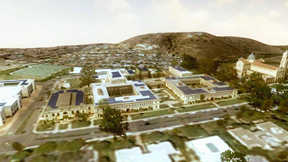
SAN DIEGO — A pair of solar energy development firms have committed to building approximately $100 million in solar energy projects totaling 20 megawatts at schools across the United States.
Solar energy developer AMSOLAR Corp. of Solana Beach, Calif., is partnering with global renewable energy investor GCL Solar Energy of Hong Kong. The companies signed a program agreement in June stating that the two companies will collectively develop solar power plants for schools under long-term power purchase agreements. GCL will fund the projects that AMSOLAR develops with schools and districts around the U.S., according to reports.
The partnership model will allow K-12 and higher education institutions to implement solar energy programs without making any up-front investments, says Josh Weinstein, Managing Partner at AMSOLAR.
“Our business focuses on supplying solar power at no upfront costs to our partner schools,” Weinstein says. “The way we do that is by offering a power-purchase agreement where we build a large solar facility on the school’s campus and they purchase power from us, for typically between 20 and 25 years.”
Weinstein says that the his company typically enters into a site lease or site easement with partner schools when designing the solar programs, each of which is usually between 1 and 5 megawatts.
“The school receives access to clean solar power with no up-front cost, allowing the institution to save money from day one because the price they pay for solar from AMSOLAR is lower than what they would typically pay the electrical utility,” Weinstein says.
The first project funded under the AMSOLAR-GCL partnership is a 1.2-megawatt solar system at the University of San Diego, where approximately 5,500 panels will be installed on the roofs of 10 buildings and atop one parking lot structure. The cost of the USD solar project is reportedly between $4 million and $6 million. Under terms of the agreement, USD has agreed to purchase the electricity from AMSOLAR at a fixed rate for the next 25 years.
When completed in September, the project at USD will be the eighth-largest solar system on a U.S. college campus, providing up to 10 percent of the university’s electricity and saving the school $70,000, or 25 percent of its electricity costs, based on July 2010 figures, according to Weinstein.
A USD official was skeptical at the actual savings amount.
“It’s a little tricky saying how much we’ll save,” says Michael Catanzaro, USD’s director of sustainability. “We just know that given the fixed rate, there is a guaranteed savings.”
Catanzaro explained that savings in energy costs is based on an estimated output that is difficult to predict from year to year.
“There’s no way to guarantee the system is going to perform at a certain level — we’ve had four sunny days in July this year,” he says. “Last year, we had about four cloudy days.”
Catanzaro says a major draw to the partnership’s proposal was the company’s ability to work with the university and the community in achieving social sustainability goals, which included implementing education and outreach opportunities around the system.
“We brought in a lot of vendors, and AMSOLAR was fairly unique in the way they approached sustainability ‘holistically,’ with a real emphasis on education and the learning opportunities around solar,” says Catanzaro. “They are going to help us put together a class, which will teach how to get maximum usage out of the solar panels.
Catanzaro added that he hopes to establish energy display dashboards around campus to show the productivity of the solar system, which will be largely hidden atop roofs.
USD is also investigating other forms of renewable energy, including fuel cell and solar thermal technology, he says.
The AMSOLAR/GCL solar energy partnership presently has a pipeline of 10 schools and school districts, located primarily on the east and west coasts, according to Weinstein, who would not reveal the names of the institutions.
Weinstein did say that collectively the schools represent K-12 and higher education, public and private. Altogether, the schools represent more than 12 megawatts of solar power, he says.

